Previously, we analyzed the evidence to make a case for what martial art Goku would be trained in if he existed in the real world. Now we’re going to look at He-Man. *This article is supported by Amazon affiliate links.
Those of you who know me know I am a massive He-Man fan. To this day, he is the primary hero paradigm for me. And with the Masters of The Universe franchise picking up steam once again with the current She-Ra cartoon (which is missing the mark on so many levels…) DC’s new run of Masters of the Multiverse, Sony’s He-Man movie, and Kevin Smith doing a He-Man show for Netflix, I feel the time is right to talk about this, and help you on your journey to become “THE MOST POWERFUL MAN IN THE UNIVERSE!”
Now, He-Man has been through multiple iterations, and his world, Eternia, has evolved a lot over the years. We’re going to split the difference much like the previous DC series did (easily my very favorite incarnation of the property!) So let’s start with defining a few things for our starting point:
#1 He-Man is essentially possessed by the spirit and power of King Grayskull.
He-Man himself doesn’t particularly “need” training, being a magical hero. However, we have many multiple instances of Prince Adam training, and we know the other masters train. And there are even occasional instances of He-Man doing tactical training. This means we’re going to have to reconstruct the cultural training method in Eternos, because we don’t have a clear example of an individual method.
This also means that He-Man’s particular aesthetic is older than the culture he lives in. By several generations. King Grayskull is a sort of Arthurian figure, and with the original Cross Pattée, the sword being more or less an arming sword, the fur trim on everything, what we’re seeing is a sort of mashup of The Teutonic Knights, and Vikings. So we’re looking at a Viking Era-to-Crusades era sort of deal (~800-~1600 CE) Which is a massive swath of time, so split the difference and say around 1200-ish, though the fur trim being indicative of cold climates and hunter-trapper culture, probably earlier rather than later.
This doesn’t really make or break the argument, but it’s good to know for context.
#2 Eternia is weird.
Eternia is a massive mashup of fantasy and science fiction. Magic is real, Technology is advanced, and we know that it exists in a time frame where Earth has deep space exploration capabilities on solo-piloted small craft.
Eternia is also the “center of the universe” and has at its heart “The Star Seed” which basically gives it some of the power of the creation of the universe.
This essentially means that though we see a sort of Renaissance-era look with insanely advanced tech, the tech may be more of a product of magic mixed with more rudimentary design, reducing many of the needs of space for power sources, material limitations, etc. In essence, we might be seeing a civilization whose technology has been mechanically stunted because of magical workarounds. Much of what we see, especially in the early 80s run of the property, looks like clockwork mechanisms somehow animated.
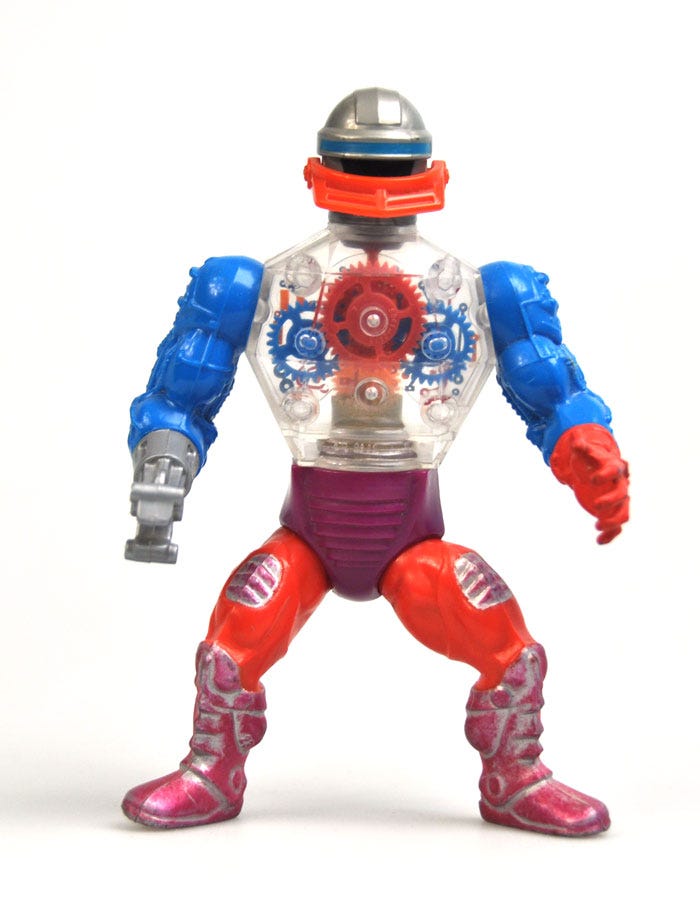
This puts us essentially in a time frame similar to the Renaissance here in reality, except Alchemy and the Occult are real. We also know that there are many other more technologically advanced civilizations in the universe and neighboring dimensions, as well as more magical places as well, evidenced by The Horde and Trolla, among others.
So onto our case study.
~~~~~~~
We have our time period analog – The Renaissance – and we know enough about the world to draw some parallels.
First, the simple part, what was the state of martial arts in Europe, especially in the Germanic territories during this time period?
Well, boxing sport wasn’t really a thing. Folk competitions were based in wrestling, and knightly competition was based in arms. In fact, there was a very robust “ren-faire” thing going on during the Renaissance where they romanticized culture from centuries past (hey, we’re all humans!) What’s funny, though, is that as treatises were being written, we see that wrestling and armed combat crossed paths more than once, and even within wrestling, outside of folk festivals, striking was not seen as a separate discipline.
From the very early (1400s) “house book” derived from Liechtenauer:
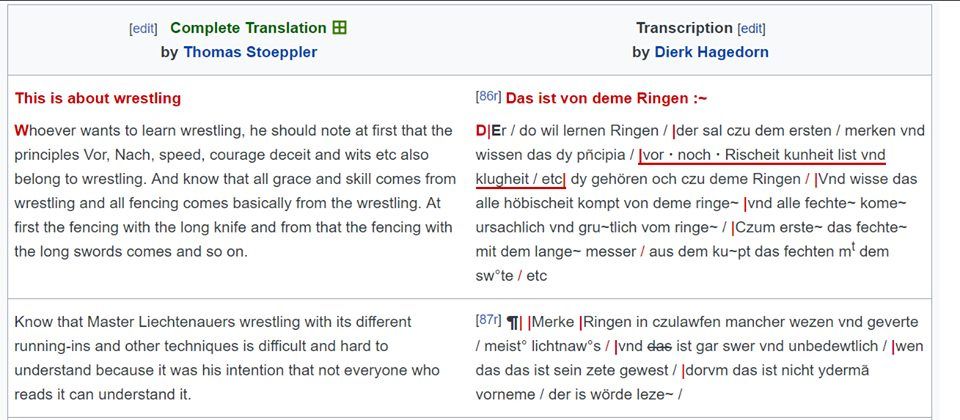
From Fiore Dei Liberi’s Flower of Battle (CE ~1410):
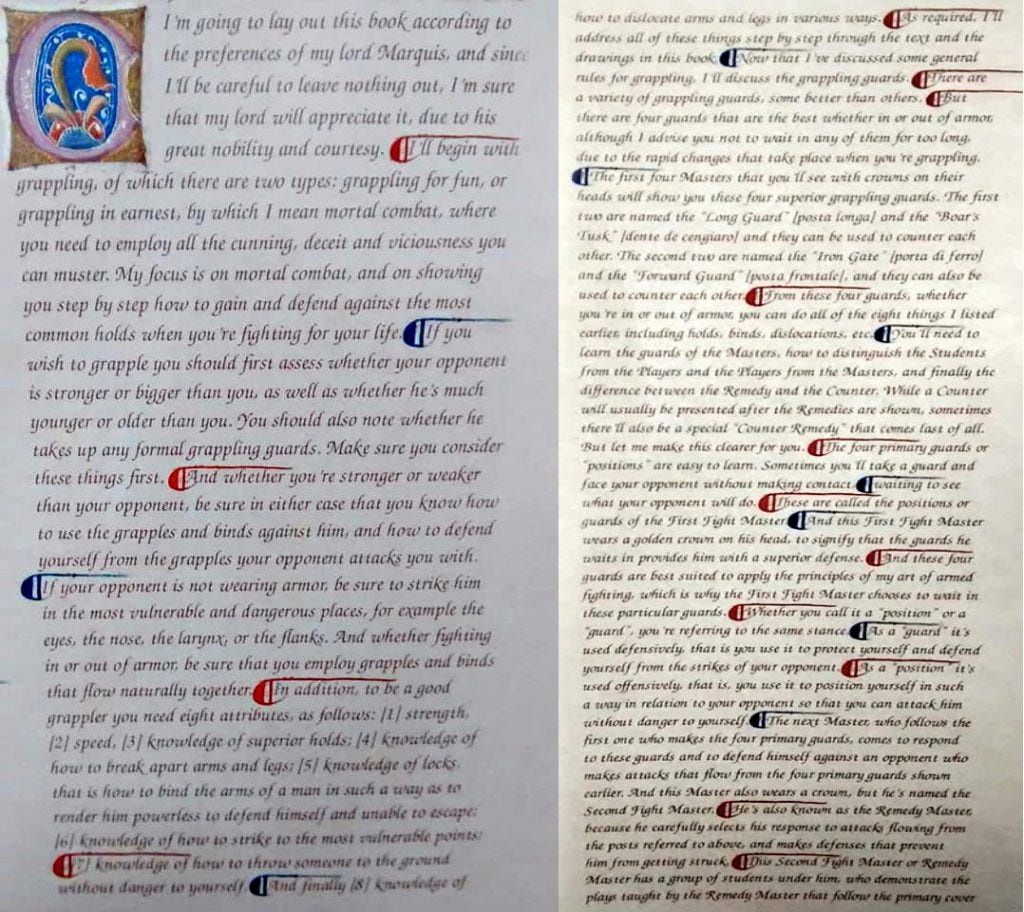
Another Italian source, though the author seems to have been Spanish, Pietro Monte’s Collectanea:
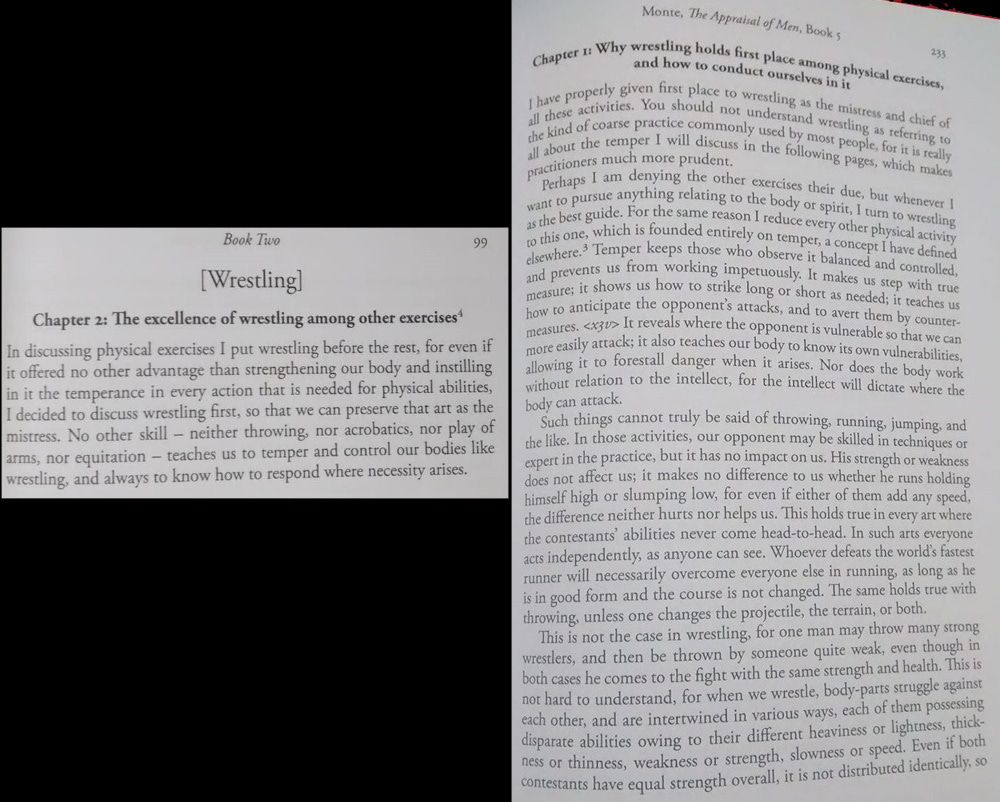
So we see a Pan-European emphasis on Wrestling, followed by armed combat. And over in Asia, we see analogs in Mongolia and Japan and India where wrestling is the primary sport of the people, and armed combat follows (China seems fairly unique in its boxing culture, well, maybe the Khmer Empire too, but even most boxing styles can’t be traced back that far, and Shuai Jiao, Chinese wrestling, is the oldest hand-to-hand style that we can trace in China) Even the vikings were famous for Glima, a method of wrestling that has been preserved in some very small pockets in Europe.
But there’s something interesting we just grazed by earlier. Wrestling outside of folk sport, was not necessarily distinct from striking. Striking was a part of it. Just like Japanese arts have atemi, and and Chinese qinna has vital point striking (dim mak), we see strikes in the grappling. From knee strikes and eye gouges in Fiore to punches and kicks in Petter…
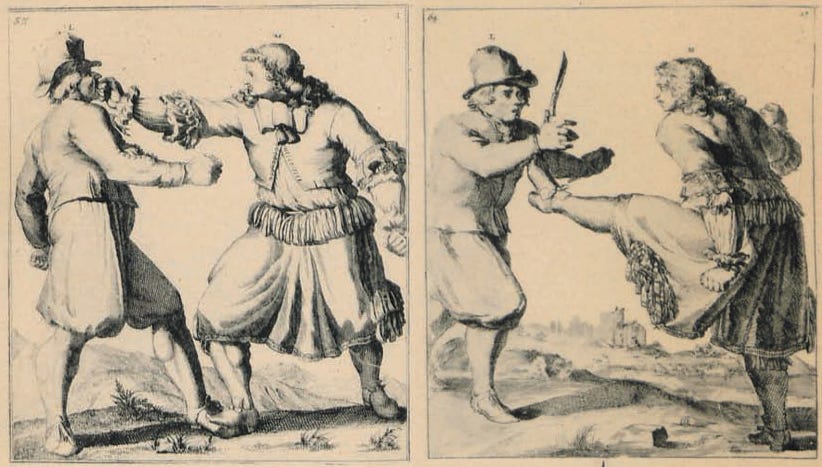
Now, we also see Prince Adam and Teela training with American Gladiator’s style “pugil-sticks”. (Seen @4:40 in the clip below, the first episode of the 200x series.)
And while we don’t have great sources for early “stick fighting” (obviously, Japan is well known for bokken/bokuto, and Filipino Martial Arts is well know for using sticks) we do have some peek that is was done in some way with English Single Stick being used as sabre/cutlass training in the navy, Palcaty, a polish stick fighting game similar to single stick, French La Canne/Canne de Combat, and, of course, the old method of quarterstaff. We also see “great stick” practice (Bastone in Italian, and Baton in French, and, interestingly, Jogo do Pao in Portugal) from several French sources and Alfred Hutton.
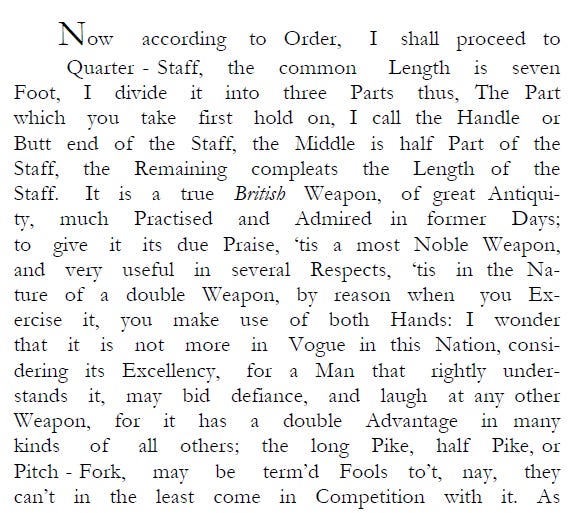
So we see on the level of hand-to-hand combat, He-Man and The Masters Of The Universe would have likely trained in striking-supported wrestling, and quite probably engaged in stick fighting as young warriors, we then need to look at the armed combat.
This is a fairly simple task as well. The majority of characters use “side arm” type weapons, varieties of swords and maces, common to the period where full harness (plate armor) was worn. Most characters, however, are not wearing full plate armor, and there are many energy weapons (most probably magical concussion blasts, not actual lasers) indicating a transitional period, much like we see in the pike-and-shot era of warfare where gunpowder started changing the battlefield. Lots of weird clashing of arms and armor, the rise of urbanization, proto-industrial forces and the discovery of science changing everything. Add magic, and this seems to be He-Man’s Eternia to a “T”.
Funny enough, He-Man being a sword and shield wielder, a technology going back to more rudimentary armor where your protection was in your hands and formation more than on your body, we see full harness going away in the Renaissance, and sword and shield come back in favor. Though the arming sword gave way to the side sword, shields, large and small, and bucklers were as popular as ever.
As far as maces and other impact weapons go, we don’t have many sources, but the pollaxe does get discussed in Fiore and Monte, cited above, and pole-hammers, war hammers, and maces would likely follow the same patterns. Perhaps because they’re not particularly a dueling tool, they were not nearly as written about.
OK, so we not have a picture of how He-Man and the Masters of The Universe would train for combat. Wrestling and stick fighting as a base, especially as teens, following up with more sophisticated weapons training when graduating from “squire” to “knight” (terms not used in MotU).
But that’s not all, is it? No, we want to know how the Masters of the Universe got jacked and tan!
Now, it’s no secret that when He-Man was invented, Bodybuilding was on top, Arnold was a new superstar, and everybody wanted that physique.
Even Dolph Lundgren discussed his specific He-Man transformation workout with Muscle & Fitness in August 1987.
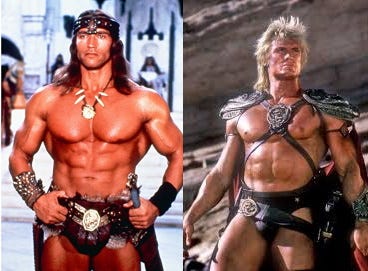
But, we know bodybuilding wasn’t a thing until the very late 1800s with the likes of Eugen Sandow. So what kind of training did people do in the Renaissance?
Well, we don’t have a ton of evidence. We know the Romans trained with heavy implements. And the story of Milo of Croton may be the earliest evidence of people understanding progressive adaptation to increasing loads over time. But the science didn’t catch up with any of that until the 20th century, and is still being refined today. Well, we have one amazing source of one man, an actual soldier who died on the battlefield in 1509, whose book was published posthumously in 1510, who proposed a series running, vaulting and throwing. Pietro Monte (cited earlier). He wrote quite extensively in his Collectanea how one should go about these tasks. You can read it in the links provided, but essentially, he was proposing a prototypical Parkour mixed with something resembling track and field.
But The Masters’ are JACKED! Parkour and Track athletes are little! OK, so maybe we’re lacking a little reality here. Magic is a PED. But maybe we do have a little hope. Strength sport goes back a long long way, and what we might see in the old days would look more like modern Strongman than bodybuilding or Olympic track and field events. But even Strongman as we know it is a 20th century sport. What goes back older?
The Highland Games, as it stands today, is 19th century, but there are records of foot races and other contests going back further. And is often considered the oldest strength sport. And we have similar such stories from elsewhere in Europe.
We know that people have been running, jumping, and lifting, and even throwing for as long as the stories go back. On top of that, for most of history, folks worked manual labor, and would have developed a significant about of conditioning through just daily living.
It is entirely reasonable, then, that The Masters’ would have been engaging in much the same. Even with the advanced magical technology, we never once see a barbell, a dumbbell, or a cable machine. Yet over and over again, He-Man and She-Ra are picking up massive stones and hucking them across the horizon.
In the modern age, you could come across real world results in this realm by taking up Parkour, Wrestling, Strongman, and Highland Games. And if that’s too much you can try out something kind of hybridized like what Brian Alsruhe does.
So how do you become a MASTER OF THE UNIVERSE? Or even THE MOST POWERFUL MAN IN THE UNIVERSE?
Train Strongman/Highland Games, Parkour, Wrestling (and don’t forget the striking!), Stick Fighting, and HEMA fencing. And maybe, just maybe, you too will toss a mountain into orbit.





